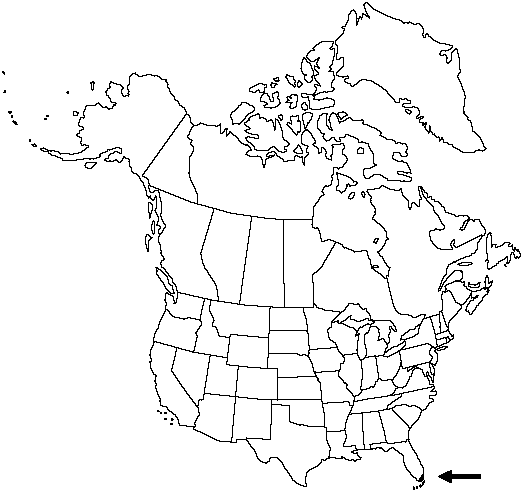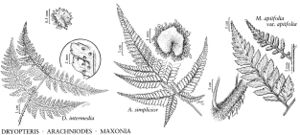Difference between revisions of "Maxonia apiifolia var. apiifolia"
FNA>Volume Importer |
GeoffLevin (talk | contribs) m (Corrected authority to match printed version) |
||
| (4 intermediate revisions by 2 users not shown) | |||
| Line 1: | Line 1: | ||
{{Treatment/ID | {{Treatment/ID | ||
|accepted_name=Maxonia apiifolia var. apiifolia | |accepted_name=Maxonia apiifolia var. apiifolia | ||
| − | |accepted_authority= | + | |accepted_authority= |
|publications= | |publications= | ||
| + | |special_status={{Treatment/ID/Special_status | ||
| + | |code=F | ||
| + | |label=Illustrated | ||
| + | }} | ||
|basionyms= | |basionyms= | ||
|synonyms= | |synonyms= | ||
| Line 18: | Line 22: | ||
|elevation=0 m | |elevation=0 m | ||
|distribution=Fla.;West Indies in Cuba;Jamaica. | |distribution=Fla.;West Indies in Cuba;Jamaica. | ||
| − | |discussion=<p><i>Maxonia apiifolia</i>, known in the flora from one collection made in 1921 in southern Florida, has not been relocated and may be extirpated. J. T. Mickel (1979) suggested that it may represent a horticultural escape, but the species is not known in cultivation. Its occurrence in Florida may indicate long-distance dispersal from the West Indies. <i>Maxonia apiifolia</i> var. dualis (J. D. Smith) C. Christensen occurs in Central America in Guatemala, Honduras, and Panama, and in South America in Ecuador. It differs from < | + | |discussion=<p><i>Maxonia apiifolia</i>, known in the flora from one collection made in 1921 in southern Florida, has not been relocated and may be extirpated. J. T. Mickel (1979) suggested that it may represent a horticultural escape, but the species is not known in cultivation. Its occurrence in Florida may indicate long-distance dispersal from the West Indies. <i>Maxonia apiifolia</i> var. dualis (J. D. Smith) C. Christensen occurs in Central America in Guatemala, Honduras, and Panama, and in South America in Ecuador. It differs from <i></i>var.<i> apiifolia</i> only by its entire, rather than denticulate, scales.</p> |
|tables= | |tables= | ||
|references= | |references= | ||
| Line 27: | Line 31: | ||
-->{{#Taxon: | -->{{#Taxon: | ||
name=Maxonia apiifolia var. apiifolia | name=Maxonia apiifolia var. apiifolia | ||
| − | + | |authority= | |
| − | |authority= | ||
|rank=variety | |rank=variety | ||
|parent rank=species | |parent rank=species | ||
| Line 40: | Line 43: | ||
|publication title= | |publication title= | ||
|publication year= | |publication year= | ||
| − | |special status= | + | |special status=Illustrated |
| − | |source xml=https:// | + | |source xml=https://bitbucket.org/aafc-mbb/fna-data-curation/src/2e0870ddd59836b60bcf96646a41e87ea5a5943a/coarse_grained_fna_xml/V2/V2_384.xml |
|genus=Maxonia | |genus=Maxonia | ||
|species=Maxonia apiifolia | |species=Maxonia apiifolia | ||
Latest revision as of 18:18, 6 December 2021
Stems 1.5–4 cm diam., internodes 3–10 cm; scales orange, brownish, or golden, denticulate. Roots from under surface. Petiole 30–60 cm, essentially glabrous, grooved adaxially. Blade broadly ovate, 3–4-pinnate, base slightly reduced, somewhat leathery, glabrous. Pinnae stalked, closely spaced to overlapping, lanceolate. Pinnules anadromous throughout. Tertiary segments obliquely ascending.
Habitat: Climbing on trees in wooded limestone hills
Elevation: 0 m
Distribution

Fla., West Indies in Cuba, Jamaica.
Discussion
Maxonia apiifolia, known in the flora from one collection made in 1921 in southern Florida, has not been relocated and may be extirpated. J. T. Mickel (1979) suggested that it may represent a horticultural escape, but the species is not known in cultivation. Its occurrence in Florida may indicate long-distance dispersal from the West Indies. Maxonia apiifolia var. dualis (J. D. Smith) C. Christensen occurs in Central America in Guatemala, Honduras, and Panama, and in South America in Ecuador. It differs from var. apiifolia only by its entire, rather than denticulate, scales.
Selected References
None.
